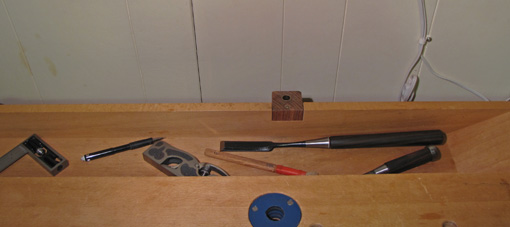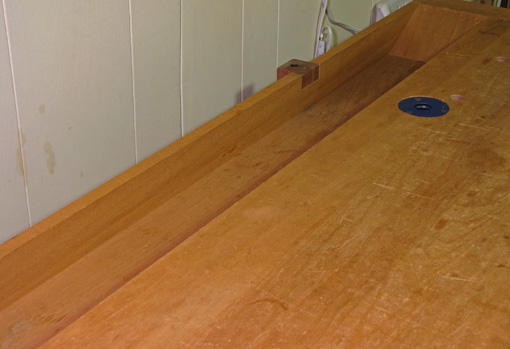This is really a matter of opinion and personal work habits, but I would like to make a case for the humble workbench tool well. The bench that I have used for more than 25 years has one and I would feel awkward working without it. Here’s why.
The tool well is a place for tools, small parts, and other sundry items not in immediate use while working at the bench. When placed there, the items are protected from bumps and dings because they lie below the level of the work surface. Think about vigorously jack planing a board, pushing the plane in various directions, and the possibility of the toe of the plane crashing a square, gauge, or straightedge. Ouch. Working a curve with a rasp, sawing joints, and paring with a chisel are other examples.
Of course, the tool in hand may also be damaged from such collisions.
Without a tool well, it will actually take up more space to place the unused tools on the work surface at a safe distance to create sufficient clearance from the work at hand to avoid feeling inhibited. Thus, the tool well saves, not wastes, space.
The work on the bench surface is likewise protected from the items in the well, such as chisels. Wood parts are rotated, pushed, and otherwise manipulated on the work surface and you want to avoid unintended meetings with tools.
The outer edge of a tool well at the end of the width of a bench should be flush with the work surface. Thus, for most purposes, the bench width effectively includes the width of the tool well. The same is true of a well in the middle of the bench width. The inside of the well on my bench is 5 1/4″ wide and 2 3/8″ deep.

Of course there are some disadvantages to the tool well. Tool wells at the end of the bench width prevent most clamping in that area. Also, there is less continuous flat area on the bench. (Though Bob Lang has a clever solution to this in a bench he designed and is detailed in Popular Woodworking.)
The disadvantage that seems to be stated most often, that the tool well collects dust and debris, is not a disadvantage at all. Yes this does happen, but I would rather the debris, such as chips from chopping joints that didn’t get swept to the floor, be out of the way in the well than sit on the work surface. Anyway, it’s no big deal to sweep out the well since there is a handy ramp at one or both ends.
So, for woodworkers who are buying, building, or upgrading their workbench, these are some considerations to keep in mind and which I hope will be helpful. There are many bench designs and many excellent sources to study. Decisions are ultimately personal, so go with what seems right for you and enjoy every minute at the bench.



I’m of the same mind, Rob. You explained it really well. Next time I argue with someone about it’s usefulness, this post will come in handy!
Agree with all you say for and against. My workbench had a tool well and I haven’t really tried to clamp on that side. If it’s up against a wall the clamp issue is a moot point. I couldn’t get over the black hole of debris it made while working. I just couldn’t keep my BP low enough while looking for a buried tool. For me and the way I worked, a tool tray was a royal pain.
I removed the tool tray bottom after a year or so and have worked without one for about 20 years now. However, I am now 20 years older, my habits (and patience) have changed and after reading your arguments I am going to give the tray another try. I especially agree with having a clean surface not littered with all your tools.
rjb
I am in the process of building my own workbench, you might wish to follow along at: carlswoodworking.wordpress.com. During the process of designing my workbench I thought long and hard about including a tool well. It’s not something I’ve ever had before, so I really didn’t know if I needed one. In the end I decided against building a well into the bench. I’m so much of a neat freak that I probably won’t be leaving tools in a well or on the bench, I’ll need to build a tool cart for them to land on. After the workbench is up and running I’ll likely experiment by hanging a tool well off the back side to find out if it’s something I really need for my next bench.
BTW: I always look forward to reading your posts. They are always on point and packed with useful information. Thanks for your efforts, keep it up.
Tico, Ralph, and Carl – thanks for the comments.
One of the problems with woodworking is that it can take a long while and many situations to make it evident what works best for you. I know I’ve backtracked, rethought, and retooled many times. I doubt that will ever end.
Ralph, let us know how it goes with the revision if you’d like. Carl, I’ll be interested to see what you choose for vises on the new bench. Veritas has an innovative tail vise available.
Rob
My previous bench had a tool well – for me, due to bad habits and laziness it tended to get very cluttered. I acquired one bench that was headed for the dump that did not have a tool well and when I moved into my new shop there was a 4 by 8 foot steel table that I have covered with melamine mdf for a work/assembly table. I keep a tool box near the bench and am within reaching distance of a pegboard wall as well as having storage under the bench for tools. I have found the storage shelf under the smaller bench to be valuable for keeping the tools I am working with handy. I will probably add a tool well in my next bench as it will be easier to get to the tools I am using rather than having to reach under the bench. Thank you for a very insightful post.
You’re welcome, and good luck with the new bench, Bill.
I love the idea of the well. I cannot even count up the number of times I’ve dropped a part or a tool off the table. Screws are the worst, because they’re hard to find.
Yea, especially when they land, as the physical laws of the universe seem to make inevitable, in a pile of sawdust and shavings.
Thanks for the comment, John.
Rob
I completely agree that it’s all very personal and all preferences are completely valid. It’s nice to just set out concrete facts about the benefits and drawbacks of each alternative.
My bench lacks a tool well, but I made a rolling cart that nests under one end of my bench when not in use and has what amounts to a small tool well on its top:
http://www.flickr.com/photos/chevy_chase_hughtos/2281043624/sizes/z/in/set-72157607001006126/
Easy to roll next to you as you work. Just another alternative.
I also agree with most of what you say, also as a fan of the tool well.
When I built my current ‘bench back in 2009, I soon grew tired of having to clear the well of all the shavings that gathered inside. So, with a a little help, I came up with the idea of fitting lidded boxes:
http://ollypj.wordpress.com/2010/02/04/trouble-with-tool-wells/
(Sorry, I hope you don’t mind the link!)
What I’d really like to find, though, is a highly convenient means of preventing tools from rolling off the back of a workbench!!
Some woodworkers will also fix the well at one end of their ‘bench (see Richard Maguire’s website). I’m leaning towards the idea of having a central tool well and may soon be taking my circular saw to the ‘bench top…!! Even if it’s not covered, you could comfortably straddle the legs of a side table, for example, either side of the well. Depending on the depth of your top, this isn’t always possible (at least, with an open rear well.
I do enjoy following your blog. Thank you. :-)
Sean and Olly,
Thanks for the comments. These again show that there’s lots of good ways to solve woodworking problems.
Olly, you might want to take a look at Bob Lang’s post just today about tool trays:
http://blogs.popularwoodworking.com/editorsblog/
Rob